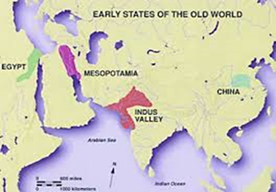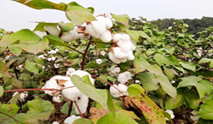Context
According to a paper published in Israel in 2022, records from the Tel Tsaf site shows cotton fibers originated in the Indian subcontinent around 5200 BCE.- However, in a recent update to the findings, mentioned that Cotton was used in India before the other countries even do not have any idea of its cultivation.
- Countries like Iraq, Greece, the Persian Gulf and North Africa all came to know about cotton thousands of years later its first use in the Indian subcontinent.
- Archaeological records trace the beginning of India’s connection with cotton to around the 7th-6th millennium BCE.
- This beginning around 8,000 years ago in Indian sub-continent paved the way for domesticating cotton, which was then spun and woven into designed textiles used domestically and exported to contemporary civilisations.

Tel Tsaf site:
|
- The history of India begins with the birth of the Indus Valley Civilization (IVC), also known as Harappan Civilization.
- It flourished around 2,500 BC, in the western part of South Asia, in contemporary Pakistan and Western India.
- The Indus Valley was home to the largest of the four ancient urban civilizations of Egypt, Mesopotamia, India and China.
- In 1920s, the Archaeological Department of India carried out excavations in the Indus valley wherein the ruins of the two old cities, viz. Mohenjodaro and Harappa were unearthed.
- In 1924, John Marshall, Director-General of the ASI, announced the discovery of a new civilisation in the Indus valley to the world.
- From the excavations of site near mountainous region of Balochistan at an archaeological site in Mehrgrah, found the first evidence of cotton during Harappan age.
- However, the Cotton species used was unclear from that site.
- It was estimated that, earlier there are four species of Gossypium (cotton) cultivated– G arboreum L, G herbaceum L, G hirsutum L, and G barbadense L – were domesticated in different regions across world at different times.
- G arboreum was domesticated in the Indian subcontinent, eventually spreading to Africa and other parts of Asia, whereas G herbaceum was first cultivated in Arabia and Syria.
About Cotton Crop:
 Types of Cotton used till present times:
Types of Cotton used till present times:
|
- The Harappan villages, mostly situated near the flood plains, produced sufficient foodgrains.
- Wheat, barley, rai, peas, sesame, lentil, chickpea and mustard were produced. Millets are also found from sites in Gujarat. While rice uses were relatively rare.
- The Indus people were the earliest people to produce cotton.
- While the prevalence of agriculture is indicated by finds of grain, it is more difficult to reconstruct actual agricultural practices.
- Representations on seals and terracotta sculpture indicate that the bull was known, and archaeologists extrapolate shows oxen were also used for ploughing.
- Most Harappan sites are located in semi-arid lands, where irrigation was probably required for agriculture.
- Traces of canals have been found at the Harappan site of Shortughai in Afghanistan, but not in Punjab or Sindh.
- Although the Harappans practised agriculture, animals were also reared on a large scale.
- Evidence of the horse comes from a superficial level of Mohenjodaro and from a doubtful terracotta figurine from Lothal.
Post Views: 247
